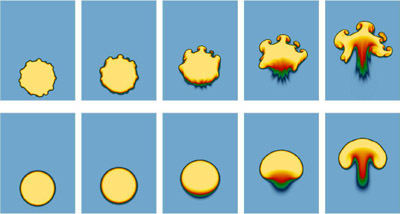academics
research
publications
os x howto
links
reaction and gravity
DNS check for initial conditions for Type Ia supernovae simulation


There are several explosion scenarios for Type Ia supernovae. All of them assume that the initial conditions of the explosion can be approximated by a bubble of hot products of a nuclear reaction that is placed sufficiently close to the star center. Because the bubble is hotter than it surroundings, it rises towards the surface of the star while growing in size. On the scale of the star the flame is very thin, making the detailed simulations impractical, thus the simplified reaction model and initial conditions are used.
A full simulation of Type Ia supernovae from initial bubble to the final explosion has been carried out at Chicago Flash Center. In the simulation, the initial bubble of the reaction product had diameter of 18 to 25 km, while being 42 and 100 km away from the center of the star. The bubble was assumed to be perfectly spherical, thus neglecting the effects of gravity, which is (however small at those distances from the star center) could potentially distort the bubble and, because of high sensitivity of the explosion process to the initial conditions, change the simulation results considerably.
We use direct numerical simulations to investigate the effects of gravity in this particular reacting flow. We simulate two miscible fluids with small density difference; a reaction mechanism transforms one fluid into the other. We use a simple reaction model that is described by a single reaction progress variable, and the Boussinesq approximation for gravity. Unlike regular hydrocarbon flames, at the initial stage of explosion the density change across the reaction front is very small and thus the Boussinesq approximation is appropriate. The combination of these two models allows us to focus on the interaction between gravity and reaction without interference of thermochemistry, compressibility, shock waves, density stratification, and other phenomena that make numerical simulations and interpretation of results much more complicated.
relevant publications
- SG Chumakov, N Vladimirova, Gravitational Effects in Reactive Flows: from physics to Large Eddy Simulation Modeling, ADTSC Nuclear Weapons Program Highlights, Los Alamos National Laboratory (2007, unclassified)
Last modified Feb 09 2024 01:57